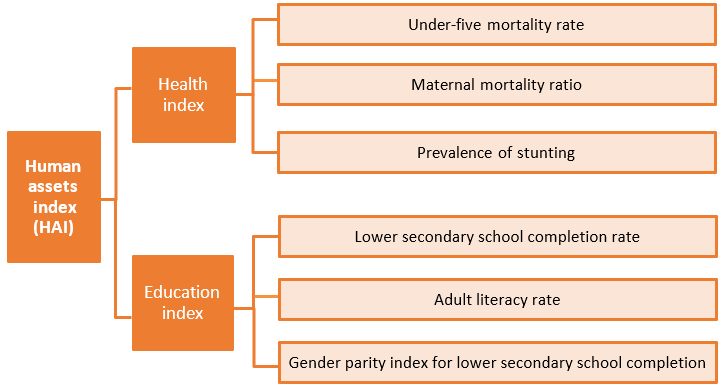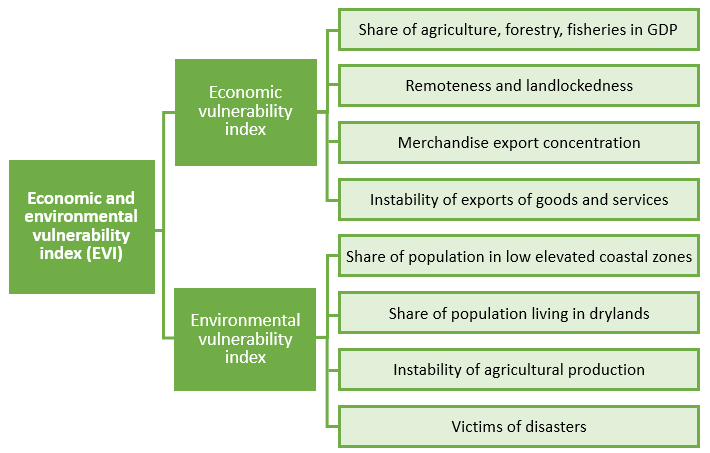LDC Criteria
The Committee for Development Policy (CDP) is mandated by the General Assembly (GA) and the Economic and Social Council (ECOSOC) to review the list of LDCs every three years and to make recommendations on the inclusion and graduation of eligible countries using the following criteria:
Income |
Human Assets |
Economic and Environmental Vulnerability |
Application and Indicator Selection
- Countries are eligible to enter or leave the LDC category if they meet the defined inclusion or graduation thresholds of the criteria. The graduation thresholds are set higher than the thresholds for inclusion. This asymmetry aims to ensure that graduation is sustainable.
- Each of the three criteria is measured using key indicators which reflect long-term structural handicaps. These indicators are chosen on the basis that they are methodologically robust, maintain stability of the criteria, ensure equal treatment of countries over time, and are frequently updated for all countries. They are periodically revised to reflect improved data availability and insights from new research.
Additional information
The Paper on the “Outcome of the comprehensive review of the LDC criteria” adopted at the CDP Plenary in 2020 can be accessed here. The “Handbook on the Least Developed Country Category provides additional information on the LDC criteria and their indicators Download the handbook: English, French, Portuguese
Gross national income (GNI) per capita
Rationale
- GNI per capita provides information on the income status and the overall level of resources available to a country
Thresholds
- The inclusion threshold is set at the three-year average of the level of GNI per capita, which the World Bank defines for identifying low-income countries. The threshold for the 2024 review is $1,088.
- The graduation threshold is set at 20 per cent above the inclusion threshold and is $1,306 for the 2024 review.
- The income-only graduation threshold is set at three times the graduation threshold and is $3,918 for the 2024 review.
Methodology
- GNI is calculated from national accounts data converted into USD using the World Bank Atlas method (to reduce impact of short-term exchange rate fluctuations)
- GNI per capita is derived by dividing GNI in USD by the annual population of a country
Data sources
- GNI per capita is calculated by the United Nations Statistics Division on the basis of its National Accounts Main Aggregates Database
- Population data are taken from the United Nations Population Division
Human Assets Index (HAI)
Rationale
- The HAI is a measure of level of human capital
- Low levels of human assets indicate major structural impediments to sustainable development
- A lower HAI represents a lower development of human capital
Thresholds
- Since 2015 the CDP uses absolute thresholds for the HAI to determine inclusion and graduation eligibility
- The inclusion threshold has been set at 60
- The graduation threshold has been set at 10 per cent above the inclusion threshold at 66
Composition
- The HAI is composed of six indicators grouped into a health and education subindex with each indicator carrying an equal weight of 1/6
- Original values for each HAI indicator are converted into index numbers using a max-min procedure
Economic and Environmental Vulnerability Index (EVI)
Rationale
- The EVI is a measure of structural vulnerability to economic and environmental shocks
- High vulnerability indicates major structural impediments to sustainable development
- A higher EVI represents a higher economic and environmental vulnerability
Thresholds
- Since 2015 the CDP uses absolute thresholds for the EVI to determine inclusion and graduation eligibility
- The inclusion threshold has been set at 36
- The graduation threshold has been set at 10 per cent below the inclusion threshold at 32
Composition
- The EVI is composed of eight indicators, grouped into an economic and environmental subindex with each indicator carrying an equal weight of 1/8
- Original values for each EVI indicator are converted into index numbers using a max-min procedure



Follow Us